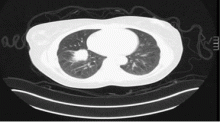The role of surgery for locally advanced non–small cell lung cancer
ABSTRACTAccurate clinical staging of patients with locally advanced non–small cell lung cancer (NSCLC) is critical in identifying surgical candidates, who are typically patients with stage N2 disease. Preoperative staging by 18F-fluorodeoxyglucose–positron emission tomography can alter staging and therefore influence the selection of therapy. The staging evaluation should include an assessment of the mediastinal lymph nodes; mediastinal lymph node involvement is a negative prognostic indicator. When the treatment plan potentially includes surgery, multidisciplinary evaluation including physiologic evaluation is essential, as surgery is aggressive with potential morbidity. Multimodality therapy offers the best chance for improved progression-free and overall survival. Patients with potentially resectable NSCLC who are downstaged following induction chemotherapy have a superior prognosis compared with those whose stage is unaltered.
Although not every patient with locally advanced non–small cell lung cancer (NSCLC) is a surgical candidate, surgery is worth considering for a subpopulation of patients who can benefit. For patients with stage III disease, choosing the optimal treatment is difficult and best done by a team skilled in managing this type of cancer.
Accurate clinical staging is extremely important to optimize treatment and outcome. The most common staging system used is the tumor, node, metastasis (TNM) system, which was revised in 2009. Surgery as a potential option for patients with lung cancer is becoming more accepted for patients with N2 disease but is still controversial for N3 disease. For the most part, surgical candidates are those with N2 or T4N1 disease. This article therefore focuses on staging and the utility of surgery in patients with N2 disease.
NONINVASIVE STAGING
Computed tomography (CT) of the chest and upper abdomen with intravenous contrast, including the liver and adrenal glands, is standard procedure for noninvasive staging of NSCLC. Contrast CT or magnetic resonance imaging of the brain is necessary to rule out brain metastasis in the patient with NSCLC for whom surgery is being considered.
At Cleveland Clinic, we have found that PET stage and pathologic stage correlate less than 70% of the time, which reflects the high incidence of histoplasmosis and other endemic inflammatory diseases of the mediastinum.
MEDIASTINAL SAMPLING
The staging evaluation includes an assessment of the mediastinal lymph nodes. Nodal sampling of the mediastinum is advised for every patient with potentially resectable NSCLC, even in the absence of an enlarged mediastinal lymph node on CT, because mediastinal lymph node involvement is a negative prognostic indicator; absence of tumor involvement of the mediastinal lymph nodes confers a more favorable prognosis.
Cervical mediastinoscopy was first introduced for lung cancer staging in 1959 and is considered the gold standard in mediastinal staging. The sensitivity and specificity approach 100% in experienced hands. A single-center experience of 2,137 cervical mediastinoscopies revealed a complication rate of 0.6% and death from mediastinoscopy in 0.05%.2 Node stations obtainable with cervical mediastinoscopy are 2R, 4R, 3, 2L, and 4L, and sometimes 10R. These are central mediastinal nodal stations.
De Leyn et al3 demonstrated that even small tumors can have lymph node involvement. Cervical mediastinoscopy was positive in their series in 9.5% of stage T1 tumors, 17.7% of T2, 31.2% of T3, and 33.3% of T4.
ENDOBRONCHIAL ULTRASOUND (EBUS) AND EBUS STAGING
Endobronchial ultrasound involves the use of a bronchoscope with an ultrasound probe mounted on it to evaluate nodal stations for suspicious lesions that require biopsy. Needle aspiration biopsy is performed by advancing a needle housed in a sheath of the endoscope, using ultrasound to identify target nodal tissue and obtain sample tissue for evaluation.
BRAIN IMAGING
Although brain metastases are uncommon, occurring in only 1% to 5% of asymptomatic patients with NSCLC, their identification is paramount when the treatment for stage III NSCLC is potentially high-morbidity surgery.
PHYSIOLOGIC EVALUATION
When the treatment plan potentially includes surgery, a multidisciplinary evaluation is essential and should involve specialists in medical oncology, radiation oncology, pulmonary medicine, thoracic surgery, and pathology.
Because surgery for stage III NSCLC is aggressive, prior physiologic evaluation is necessary to assess operative risk. Pulmonary function evaluation should include spirometry, measurement of arterial blood gas values, diffusion capacity (transfer factor of the lung for carbon monoxide), 6-minute walk test, and cardiopulmonary exercise testing.
Stress testing, whether by nuclear imaging or dobutamine echocardiogram, is also indicated, especially if considering pneumonectomy. A quantitative ventilation-perfusion scan is indicated for a more definitive evaluation of pulmonary function.







